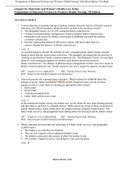Exam (elaborations)
OB, Maternity FULL Test BANK Foundations of Maternal-Newborn and Women's Health Nursing 7th Edition Murray Test Bank
- Course
- OB test Bank
- Institution
- 123 University
OB test Bank, Maternity Foundations of Maternal-Newborn and Women's Health Nursing Full test bank including all chapters and rationals, Including chapter 1-27 Exam (elaborations) OB test Bank Foundations of Maternal-Newborn and Women's Health Nursing ISBN: 9707
[Show more]



